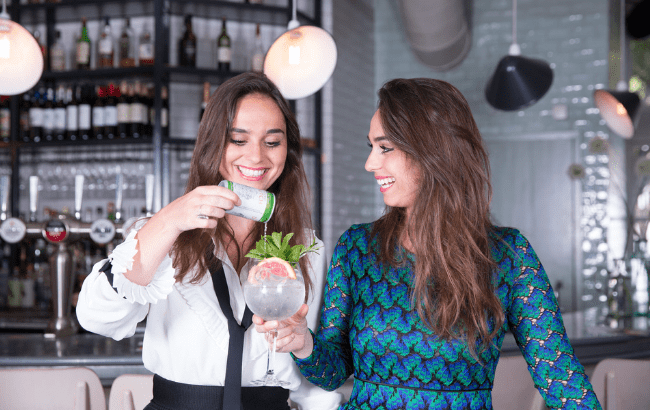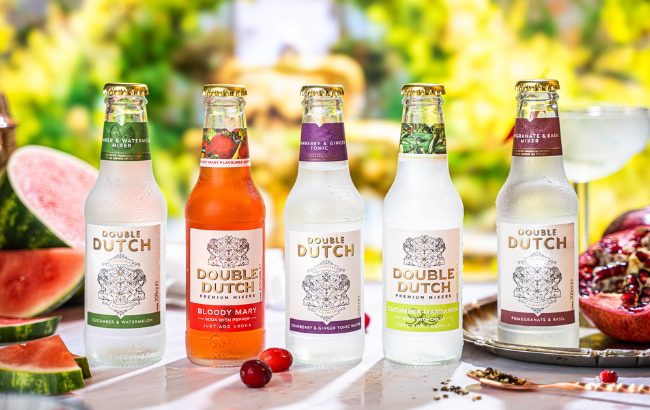SB meets… Double Dutch founders
Since launching mixer brand Double Dutch in 2015, Joyce and Raissa de Haas have gained investment from brewing giant Heineken and entered the US market. We spoke to the twins about their plans for global expansion.

How has the business grown in the past year and since the pandemic?
Raissa: We’ve seen some good growth. We launched our Pink Grapefruit, mostly in the US, with a focus on the Paloma serve. That’s one of the fastest-growing [mixers] in the UK as well. People are serving more spirit-mixer serves since the pandemic versus before the pandemic. I think it’s all about driving super-easy, two-ingredient cocktails. We’ve seen non-alcoholic cocktails massively go up. That’s something that we focus on a lot with our flavoured mixers, through one- to three-maximum ingredient cocktails that are really consistent and easy to make, especially in high-volume bars, but also to elevate the non-alcoholic serve without the addition of a non-alcoholic ‘spirit’ because that often increases the cost of a cocktail. Working with a few slightly more cost-efficient ingredients and adding a premium mixer often gives good margins for bars and restaurants.
Have you seen your share increase in the off-trade as more people consume spirits at home?
Raissa: The on-trade still takes up the majority of our business. I think people want something different when they go out, especially after the pandemic and with the cost-of-living crisis. So I do think that helps with the super-premium segment, where we are mostly focused and where we have really good distribution. The on-trade is where we are building the brand and where we put the majority of our efforts and resources. Retail and grocery are very important – to have that point of purchase for consumers – but we are driving them very much through the on-trade.
Which are your biggest markets currently and where are you focusing on?
Joyce: The UK is our home market, and it’s a big focus for us. The Middle East is a growing market for us. That whole region is up and coming and we have the right distributor there. Belgium and the Netherlands are key markets where we’re driving deeper distribution. We see really good growth in Italy and in Eastern Europe, like Romania. The Czech Republic is important. And we’re putting our efforts in Asia. We’ve just started with a good distributor in China and Hong Kong, and we’re looking into Singapore, Taiwan and Japan to have the cornerstones for further growth in the next few years, to really get distributors on board in those areas. A completely untapped market for us at the moment is Latin America – there are some key markets that are really interesting, like Mexico and Brazil.
How has the US business performed since entering the market last year?
Joyce: We see really good growth opportunities in the US. But with the cost of goods in the past 18 months, it’s been quite challenging and interesting at the same time to see where we should focus on. Our focus is now very much on Miami, rather than Florida, for example, and Los Angeles rather than California. We take a city approach in our key states to really get it right. For example, we are hiring for local sales teams in Miami and LA to drive our growth in a specific smaller area to create a loyal customer base, and then move out of the city. We definitely overestimated at the beginning how easy it is to launch in a state; it’s better to be focused on city centres. It’s such a growing market – premium mixers are still at the beginning of that curve.
Have you had challenges with shortages of materials or high prices?
Joyce: We’ve definitely seen that getting better. We haven’t had any issues in terms of supply – we’ve had consistent supply across the range over the past two years. We’ve been lucky there; I’ve been really contingent on having multiple suppliers in case things happened. Obviously, we’ve seen a big increase in our cost base, both from filling costs to glass, which uses a lot of energy. In the past 12 months, we have seen a really big increase in our cost base on glass. Shipping has gone down, but it’s still up from where it was before Covid. We’re swallowing costs because we can’t forward all costs to our customers. It’s about maintaining our quality, which is the biggest concern for us at the moment. It’s about mitigating the risk and seeing how we can decrease our pricing step by step in the next 12 months.
Have you looked at alternative packaging?
Raissa: Yes, we are doing quite a lot of research and development into different packaging within aluminium and cans. We are also looking at other forms. There’s a lot of innovation, especially in the spirits industry, but it’s difficult with carbonisation. There are a lot more challenges and restrictions on that. We have some exciting new projects in the pipeline.

Are you working on any new flavours or new products?
Raissa: We are looking at a wide range of category innovations, like when we launched our cocktail sodas three years ago. We’re also looking outside of our core mixer category and into wider soft drinks. We are exploring and doing lots of market research at the moment. There are some clear trends of health and wellness – low calories and low sugar are becoming super important.
Would you look into market-specific flavours?
Joyce: In Asia, we’re seeing requests for more Asia-inspired flavours, for example. It’s something that we’re developing and doing research into – could we make a tonic with wasabi or garlic, for example – and looking towards local trends. I think that’s an interesting route because it really fits our brand purpose; we’re all about flavour and we want to work with seasonality, with local ingredients. So that is something we would absolutely launch for a wider range of markets, not just for one country, but maybe for the whole of Asia.
Some flavours are doing well in some countries and others aren’t. Our hero product is almost always our Cucumber & Watermelon, which we see as our key product. There are markets where our Pomegranate & Basil is more popular, so I think we’ll see more different preferences within the range.
What made you decide to sell a minority stake to Heineken?
Joyce: I think a business like Double Dutch can really benefit from expertise from a company like Heineken. They’ve been instrumental in our growth and extremely supportive. They are a fantastic partner for us. They’re owned by a woman, and they have the same values as Double Dutch with its Dutch heritage. Value-wise, there are a lot of similarities in how we want to build and grow the business.
How has the company’s investment specifically helped Double Dutch?
Raissa: Their experience translates into tangible actions for us, into what should we focus on in terms of good drivers, both in market-entry strategies, but also in our core markets in the UK. How do we really drive the on-trade as well as retail, and how to structure our obligations and finances and our filling partners – it’s a lot more of the back-end support. And support with introductions into export countries.
Are there any targets you would like to hit in the next couple of years?
Joyce: Definitely drive deeper distribution in core markets to really become the number two [mixer] in Belgium, Netherlands and the UK. And become the number one in areas like the UAE and the Middle East, where we have first-mover advantage. New product development is really important and we want to drive innovation in our category [through] new products that other competitors haven’t really launched yet.
Has the tonic and mixer market become oversaturated?
Joyce: Compared to the premium spirits market, there are still a lot fewer competitors. There are five companies competing for a similar space. It’s a different space. Because, of course, with gins, you have five or 10 behind the bar and, with tonic water, you usually have one. But I don’t think it’s too overcrowded. It is competitive, because the majority of the players in the mixer market are the big corporates who have a billion-dollar company behind them. The category is large enough for three, four or five big players to play in.
Related news
Top 10 spirits launches in June
